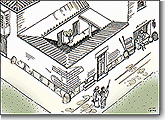Attic private law relied entirely on the concept of the oikos, which refers to a simple and at the same time felicitous definition of it as "a set of persons, things and religious habits". The oikos was subject to a completely separate law from that of the polis. The connecting link between the two was the citizen, who was, besides being an active member of the institutions of the polis, the head of the oikos he belonged to.
|  |
Not that the city was indifferent to what went on in the oikos. It dealt with the head of the family as the master and manager of the family property, which was at the same time, however, the object of coproprietorship with the remaining members. This was why the city also retained the right ot intervene in cases where the established ownership situation was being disturbed; to define hereditary settlements; and to maintain some control over marriage and divorce. It had closer control over the entry of a new member to the oikos through adoption; and over the transfer of property by a will or by intestacy. Special arrangements envisaged the case of a citizen not fulfilling his obligations towards the members of his oikos. The means whereby the possibility of intervention was secured was the graphe kakoseos, that is to say, a charge of violating the rights of members of the household, that could be brought by any third party against the head of the family. Moreover, the graphe asebeias permitted a charge to be brought against anyone who did not take steps to deal with the punishment of a killing within his family.
The term was of decisive importance for understanding family law regulations. Anchisteia included all relations created within the bounds of the legitimate family, and defined kinship and degrees of kinship, something of exceptional importance in many cases: for example, inheritance, epikleros claims, and trial for killing. It extended to include the children of first cousins, that is to say fifth-degree kinsfolk.












